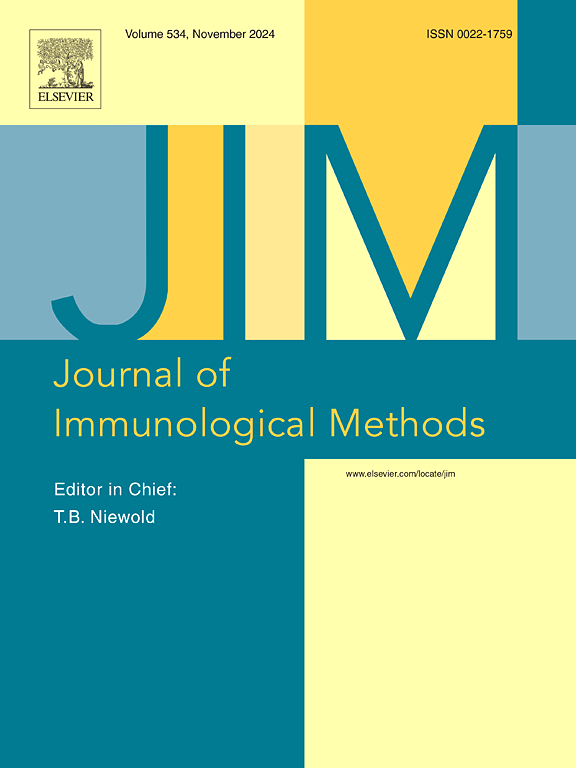Development of a high-sensitivity assay for direct quantitation of EGFr on extracellular vesicles in plasma
IF 1.6
4区 医学
Q4 BIOCHEMICAL RESEARCH METHODS
引用次数: 0
Abstract
Extracellular vesicles (EVs) play an important role in intercellular communication and hold promise for cancer diagnostics and therapeutic monitoring, particularly in Epidermal Growth Factor receptor (EGFr)-driven malignancies. This study aims to develop a method to quantitate EGFr on EVs directly in plasma samples without using an EV purification step first. Additionally assays for quantitating the total concentrations of EVs were established. The assays were developed using Single molecule array (Simoa) technology with antibodies targeting the EV surface markers EGFr, CD9, CD63 and CD81. Plasma samples from healthy individuals and cancer patients were used for assay development, validation and testing. In this pilot study we observed a lower concentration of EGFr on EVs in cancer patients as compared to healthy individuals, though the difference was not statistically significant. The total EV concentrations were significantly increased in plasma from cancer patients compared to healthy individuals (p < 0.0001). Positive correlations were observed among the total EV assays (r = 0.6, p < 0.0001). The developed EV assays present non-invasive methods for quantitating both total EVs and EGFr on EVs directly in plasma samples. Next step will be a comprehensive validation using large cohorts of cancer samples to explore the clinical relevance.
血浆细胞外囊泡中EGFr的高灵敏度直接定量测定方法的建立
细胞外囊泡(EVs)在细胞间通讯中发挥着重要作用,并在癌症诊断和治疗监测中具有前景,特别是在表皮生长因子受体(EGFr)驱动的恶性肿瘤中。本研究旨在开发一种直接在血浆样品中定量EV上EGFr的方法,而无需首先使用EV纯化步骤。此外,还建立了测定ev总浓度的方法。检测采用单分子阵列(Simoa)技术,抗体靶向EV表面标记物EGFr、CD9、CD63和CD81。来自健康个体和癌症患者的血浆样本用于分析开发、验证和测试。在这项初步研究中,我们观察到与健康个体相比,癌症患者EVs中EGFr浓度较低,但差异无统计学意义。与健康个体相比,癌症患者血浆中EV总浓度显著升高(p <;0.0001)。总EV测定值之间存在正相关(r = 0.6, p <;0.0001)。开发的EV检测方法提供了一种非侵入性方法,可以直接定量血浆样品中EV的总EV和EGFr。下一步将是使用大量癌症样本进行全面验证,以探索临床相关性。
本文章由计算机程序翻译,如有差异,请以英文原文为准。
求助全文
约1分钟内获得全文
求助全文
来源期刊
CiteScore
4.10
自引率
0.00%
发文量
120
审稿时长
3 months
期刊介绍:
The Journal of Immunological Methods is devoted to covering techniques for: (1) Quantitating and detecting antibodies and/or antigens. (2) Purifying immunoglobulins, lymphokines and other molecules of the immune system. (3) Isolating antigens and other substances important in immunological processes. (4) Labelling antigens and antibodies. (5) Localizing antigens and/or antibodies in tissues and cells. (6) Detecting, and fractionating immunocompetent cells. (7) Assaying for cellular immunity. (8) Documenting cell-cell interactions. (9) Initiating immunity and unresponsiveness. (10) Transplanting tissues. (11) Studying items closely related to immunity such as complement, reticuloendothelial system and others. (12) Molecular techniques for studying immune cells and their receptors. (13) Imaging of the immune system. (14) Methods for production or their fragments in eukaryotic and prokaryotic cells.
In addition the journal will publish articles on novel methods for analysing the organization, structure and expression of genes for immunologically important molecules such as immunoglobulins, T cell receptors and accessory molecules involved in antigen recognition, processing and presentation. Submitted full length manuscripts should describe new methods of broad applicability to immunology and not simply the application of an established method to a particular substance - although papers describing such applications may be considered for publication as a short Technical Note. Review articles will also be published by the Journal of Immunological Methods. In general these manuscripts are by solicitation however anyone interested in submitting a review can contact the Reviews Editor and provide an outline of the proposed review.

 求助内容:
求助内容: 应助结果提醒方式:
应助结果提醒方式:


